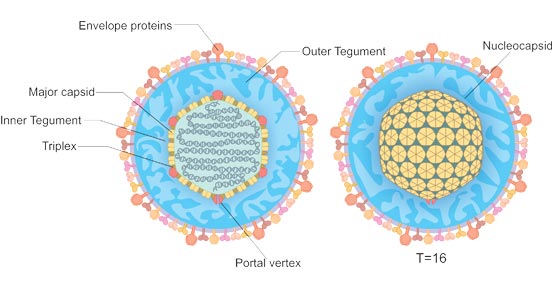Herpesviruses
Herpesviridae is the name of a family of enveloped, double-stranded DNA viruses with relatively large complex genomes, also known as herpesviruses. They replicate in the nucleus of a wide range of vertebrate hosts. Of the more than 100 known herpesviruses, 8 routinely infect only humans. They are the herpes simplex virus 1, herpes simplex virus 2, varicella-zoster virus, Epstein-Barr virus, cytomegalovirus, Human herpesvirus-6, Human herpesvirus-7, and Kaposi's sarcoma herpes virus.
In this article, we mainly discuss human herpesviruses, including structure, classification, diseases, and transmission.
Virion Structure
The herpesvirus genome consists of a non-segmented, linear, double-stranded DNA molecule. Genome lengths range from approximately 120 to 250 kbp and encode for 70 to 200 genes.
Herpesviruses have a unique four-layered structure:
- Core: The core consists of a single linear molecule of dsDNA in the form of a torus.
- Capsid: Surrounding the core is an icosahedral capsid with a 100 nm diameter constructed of 162 capsomeres.
- Tegument: Between the capsid and envelope is an amorphous, sometimes asymmetrical. It consists of viral enzymes, some of which are needed to take control of the cell's chemical processes and subvert them to virion production, some of which defend against the host cell's immediate responses, and others for which the function is not yet understood.
- Envelope: The envelope is the outer layer of the virion and is composed of altered host membrane and a dozen unique viral glycoproteins. It is spherical to pleomorphic, 150-200 nm in diameter, T=16 icosahedral symmetry.

Figure 1. The structure of herpesviruses
Classification
Herpesviruses are divided into three groups:
α herpesviruses: Herpes simplex virus types 1 and 2, and varicella-zoster virus, which have a short replicative cycle, induce cytopathology in monolayer cell cultures, and have a broad host range.
β herpesviruses: Cytomegalovirus, and human herpesviruses 6 and 7, with a long replicative cycle and restricted host range.
γ herpesviruses: Epstein-Barr virus and human herpesvirus 8, with a very restricted host range.
Now, there are more than 130 herpesviruses are known, some of them from mammals, birds, fish, reptiles, amphibians, and mollusks. Nine herpesvirus types are known to infect humans.
Table 1: The classification of human herpesviruses
| Name |
Genus |
Synonym |
Subfamily |
Primary Target Cell |
| HHV‑1 |
Simplexvirus |
Herpes simplex virus type 1 (HSV-1) |
Alpha (α) |
Mucoepithelial |
| HHV‑2 |
Simplexvirus |
Herpes simplex virus type 2 (HSV-2) |
Alpha (α) |
Mucoepithelial |
| HHV‑3 |
Varicellovirus |
Varicella zoster virus (VZV) |
Alpha (α) |
Mucoepithelial |
| HHV‑5 |
Lymphocryptovirus |
Cytomegalovirus (CMV) |
Beta (β) |
Monocytes and epithelial cells |
| HHV-6A and 6B |
Roseolovirus |
Human herpesvirus 6 |
Beta (β) |
T cells |
| HHV-7 |
Roseolovirus |
Human herpesvirus 7 |
Beta (β) |
T cells |
| HHV‑4 |
Cytomegalovirus |
Epstein–Barr virus (EBV) |
Gamma (γ) |
B cells and epithelial cells |
| HHV-8 |
Rhadinovirus |
Kaposi's Sarcoma-associated herpesvirus (KSV) |
Gamma (γ) |
Lymphocyte and other cells |
Diseases
Below are the diseases caused by human herpesviruses, and the symptoms of the diseases.
Table 2: The diseases caused by human herpesviruses
| Virus |
Disease |
Signs/ Symptoms |
| HSV1, HSV2 |
Herpes simplex |
Sores or ulcerations, fever blisters, flu-like discomfort |
| VSZ |
Chickenpox, Shingles |
Skin rash, blisters, fever, pain, sore throat, headache, stomach ache |
| CMV |
CMV infections, Mononucleosis |
Fever, rash, sore throat, nausea, muscle aches, swollen glands, fatigue |
| EBV |
EBV infectious mononucleosis, associated with Burkitt's lymphoma and other malignancies |
Fever, rash, sore throat, nausea, muscle aches, pain, swollen lymph nodes, fatigue, weight loss, vomiting |
| HHV6, HHV7 |
Roseola (exanthem subitum) |
Fever, swollen glands, runny nose, mild diarrhea, swollen eyelids, fatigue, rash |
| KSHV |
Kaposi's sarcoma (KS) |
Characteristic skin lesions, lymphoma, non-specific symptoms (fever, weight loss, etc.) |
Transmission
Most human herpesviruses are transmitted from person-to-person when a susceptible individual has direct physical contact with an infected person. Some herpesviruses may also spread through airborne transmission. The transmission of human herpesviruses is summarized in the following table.
Table 3: The transmission of human herpesviruses
| Virus |
Transmission |
| HHV-1 (HSV1) |
Contact with lesions and body fluids. |
| HHV-2 (HSV2) |
Sexual, infection at birth by a genitally-infected mother. |
| HHV-3 (VSZ) |
Contact, respiratory route. |
| HHV-4 (CMV) |
Saliva, sexual (probable), transplacentary. |
| HHV-5 (EBV) |
Infected body fluids (urine, saliva), transplacentary, transplantation, blood transfusion. |
| HHV-8 (KSHV) |
Saliva, sexual. |


